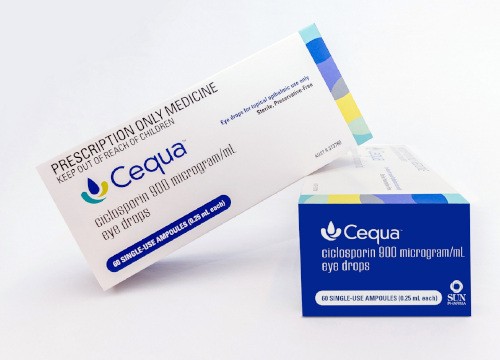Industry News
PBS Listing of Novel Treatment for Adults Living with Chronic, Severe Dry Eye Disease with Keratitis
 CEQUA TM (ciclosporin 900 microgram/mL) – an aqueous, nanomicellar ophthalmic ciclosporin solution indicated for increasing tear production in moderate to severe dry eye disease where prior use of artificial tears has not been sufficient has been listed on the Pharmaceutical Benefits Scheme (PBS) for a subsection of patients living with chronic, severe dry eye disease with keratitis. CEQUA inhibits T-cell activation and inflammatory cytokine production, thereby reducing underlying inflammation associated with dry eye disease, and stimulating natural tear production.
CEQUA TM (ciclosporin 900 microgram/mL) – an aqueous, nanomicellar ophthalmic ciclosporin solution indicated for increasing tear production in moderate to severe dry eye disease where prior use of artificial tears has not been sufficient has been listed on the Pharmaceutical Benefits Scheme (PBS) for a subsection of patients living with chronic, severe dry eye disease with keratitis. CEQUA inhibits T-cell activation and inflammatory cytokine production, thereby reducing underlying inflammation associated with dry eye disease, and stimulating natural tear production.
The PBS listing of CEQUA is based on two randomised, vehicle-controlled clinical studies. Both studies demonstrated clinically and statistically significant improvements with CEQUA in tear production and ocular surface integrity in patients living with dry eye disease over 84 days (12 weeks). CEQUA significantly reduced the signs of dry eye disease rapidly, with noticeably reduced corneal staining at 28 days, and reduced conjunctival staining at 56 days. To achieve the best results, CEQUA is recommended to be administered consistently for at least three months.
According to leading Ophthalmic Surgeon, Dr Alison Chiu, Envision Eye Centre and Greater Western Sydney Eye Surgeons, Sydney, dry eye disease is a widespread and complex disease that can have significant adverse effects on patients’ quality of life. Importantly, we as Ophthalmologists also see the benefits on surgical outcomes when dry eye disease is adequately recognised and treated. “Dry eye disease is highly prevalent, affecting nearly 25 per cent of the Australian population. As a leading cause of patient visits to both optometrists and ophthalmologists, the disease also places a substantial burden on the healthcare system. The management of dry eye disease is highly complicated because of its multifactorial aetiology. Ocular lubricants such as artificial tears are a mainstay of disease management, however only provide palliative relief and do not target the underlying pathophysiology of dry eye disease,” said Dr Chiu. “Subsequently, one in five patients living with dry eye disease are dissatisfied with their overall treatment due to lack of symptom relief, the time taken to relieve symptoms, and treatment side-effects. Ciclosporin was the first agent used in the treatment of dry eye to address the pathogenesis of the disease, and is recommended as one component of advanced treatment regimes for dry eye disease. However, the delivery method has been historically challenging,” Dr Chiu said. “As clinicians, we welcome the availability of another treatment on the PBS, to help address the current unmet need for this patient population living with chronic severe dry eye disease.”
CEQUA’s nanomicelles are formed using polymers that self-assemble into a hydrophobic core and a hydrophilic outer shell, enabling the ciclosporin molecules to overcome solubility challenges. This nanomicellar technology allows for a more than 10-fold increase in the aqueous concentrations of ciclosporin compared with cyclosporin 0.05% ophthalmic emulsion. 6,12,17 Furthermore, the smaller particle size of CEQUA improves the bioavailability and physiochemical stability of the formulation, thereby enhancing delivery of ciclosporin to relevant ocular tissue.



